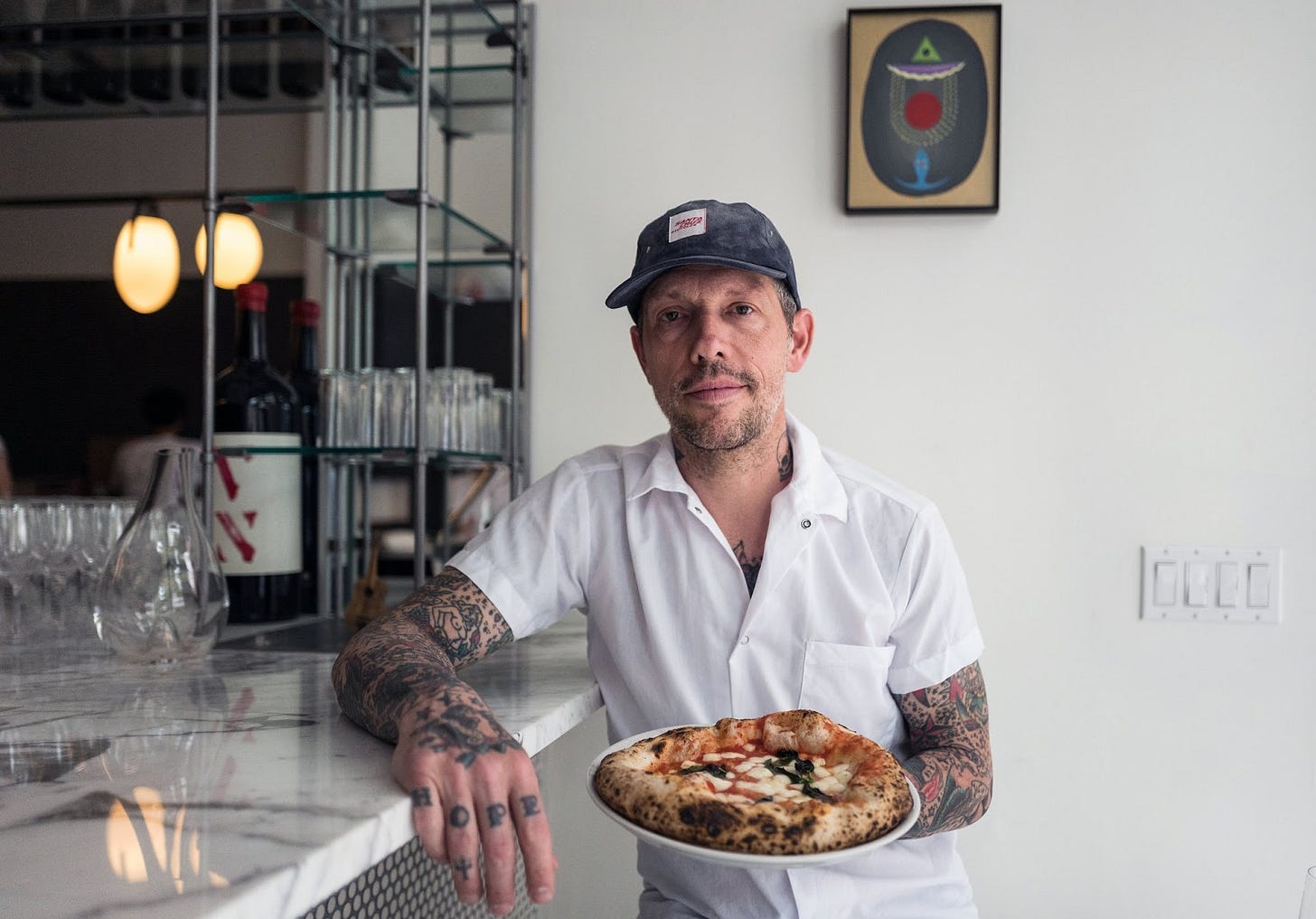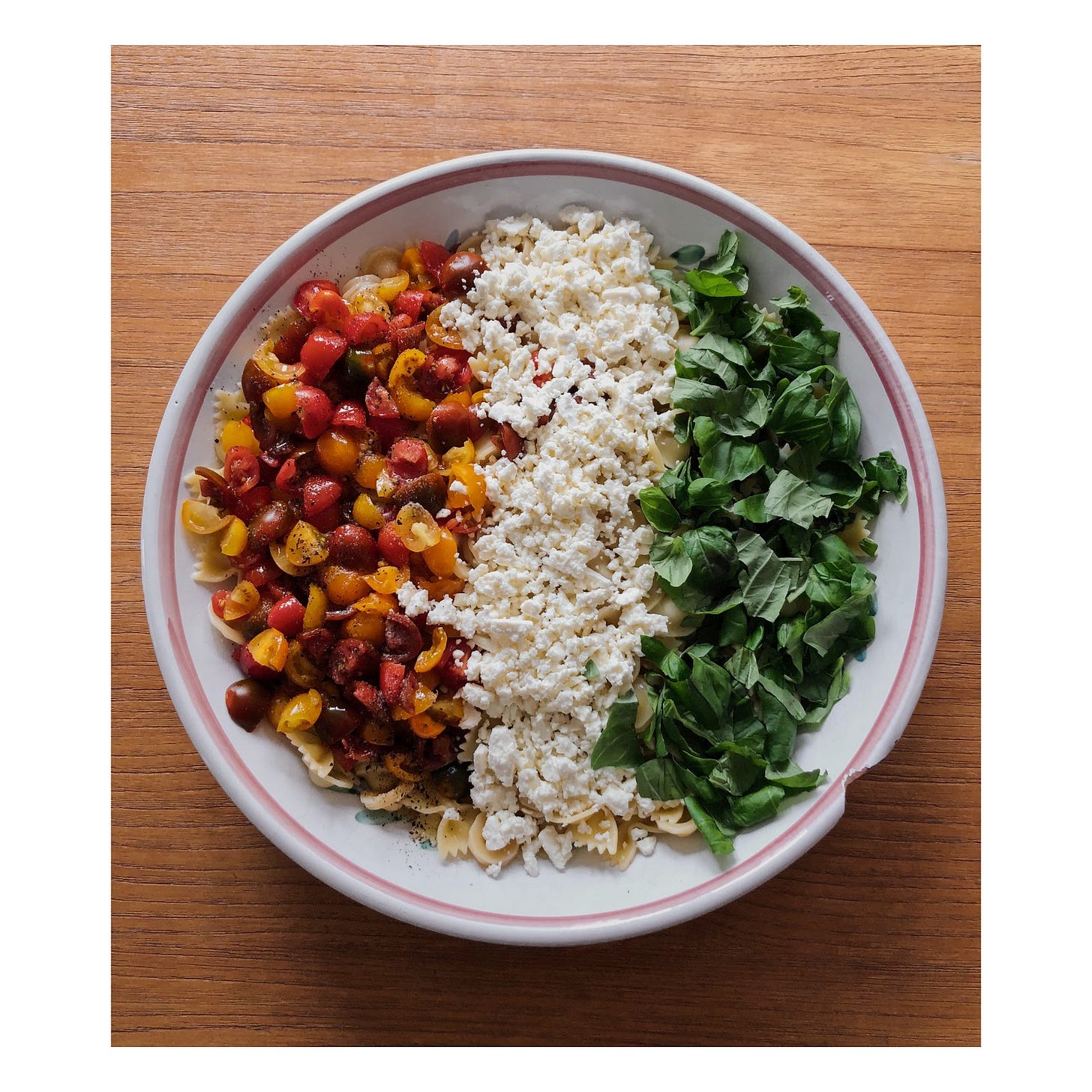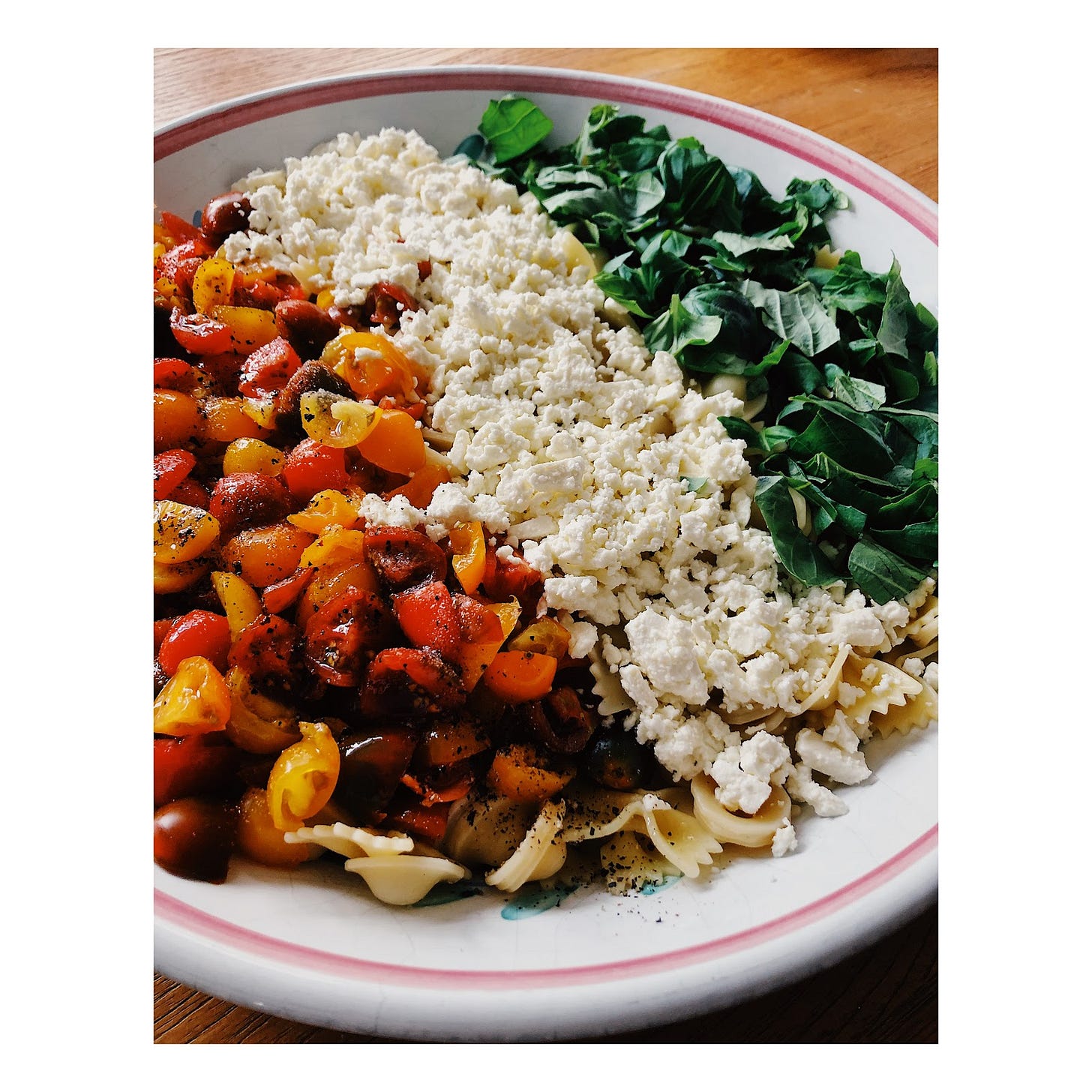Perfect Pasta Recipes From The World’s Preeminent Pizzaiolo
But first, a kind of sappy intro from me.

Photo Credit: Daniel Krieger, NYT
In early July, 2009, New York Magazine ran a 2,300 word profile of Anthony Mangieri’s Una Pizza Napoletana. Over the following days, the line for Mangieri's neapolitan masterpieces wrapped around 12th street, extending up 1st Avenue. In a city where pizza is religion, Mangieri was a prophet.
Later that month, he vanished. Like he was Jay-Z after The Black Album. Or Rocky Marciano after his 49th heavyweight fight. This broke my heart, because Una Pizza Napoletana had been my favorite restaurant since I first ate a filetti pie at 10 years-old, a few weeks after I hit a buzzer beater in the Safe Haven Basketball League. (Yes, I peaked at 10.)
I still remember Anthony’s departure leaving me with a lot of questions, as it did many New Yorkers. Why’d he leave? Where was he going? What would he do next? I didn’t have answers to those queries, but here’s what I did know: I would really miss his pizza. And I would find a way to have it again.
Fast-forward eight years. I’m in San Francisco on one of my first work trips, with three hours until a flight, and I realize Anthony is making pizza again somewhere near the Mission District. So I run over to his new place. I order a filetti pie, adorned with cherry tomatoes, olive oil, fresh basil, garlic, and buffalo mozzarella. I eat it. I see God. Briefly. And for some reason, I decide I need to speak to Anthony—to tell him what his pizzas had meant to me as a kid; and to let him know how empty New York felt without him.
But when I reach his pizza oven, and begin to feel its heat on my face, I freeze, immobilized by fear. I’m completely star-struck, as though I’m standing in front of the real Jay-Z. And instead of leaving Anthony with an eloquent proclamation of gratitude, I say something more like: “Thanks.”
Anthony’s response? “I’m glad you enjoyed the pizza.”
Fast-forward a few more years, and Anthony re-opens in New York. I start going to his restaurant as much as I can. Only now, as an adult. And I’m actually able to put together a few cogent sentences when I speak to him; I’d go as far as to say we’re friends. But when we hopped on the phone for this interview, I felt like a little kid again. Because I was so excited to find out what Anthony was cooking during quarantine. And let me tell you: He did not disappoint.
Turns out, Anthony, the world’s preeminent pizzaiolo—who used to serve nothing else at his restaurant—prefers to cook pasta at his home. And he and his wife do it “almost every single day.”
Over the course of our short conversation, Anthony dropped great tips for stocking your pantry—and shared some world-class pasta recipes, including one for a simple dish he calls “The Italian Flag,” pictured below.

These are the perfect meals to cook during quarantine—or, really, anytime—so I hope you make them. And, if you do, please send me pics of your own “Italian Flags,” so I can forward them to Anthony.
That is, if I can muster the courage to text him.
What he’s cooking instead of pizza
Anthony: We always have an insane amount of pasta in the house. We always have a lot of different kinds of beans. We always have a lot of different kind of cheeses, cured cheeses. My wife coming from Naples and me coming from a family that comes from that part of Italy, I think we both tend to gravitate towards the same things that we need to have in the house.
I would say we eat pasta almost every single day. We tend to do a lot of pastas with different vegetables. I’m a big fan of broccoli rabe, so that’s the kind of Italian-American staple I always want to have in the house.
How to make “The Italian Flag”
Anthony: One dish that I love to make uses ricotta salatta, which is aged, cured ricotta cheese, and it’s salty, so it’s got an insanely long shelf life.
Editor’s Note: Ricotta salata appears to be available *in abundance* on Amazon.
You need pasta, extra virgin olive oil, salt, and pepper. I usually try to use fresh basil but if you don’t have that, you can use dried oregano. And fresh tomatoes—or, this time of year, you can use sundried tomatoes.
What’s so great about it is you don’t have to cook anything but the pasta. So I call this dish “The Italian Flag,” because when I would cook the pasta—usually orecchiette or cavatelli—once they’re done, I just put it in a bowl, and I make three rows that look like the Italian flag.
One row is the sundried or fresh tomatoes, one row is the ricotta salata, and one row is the basil. You just sprinkle it with salt and pepper and pour olive oil all over it. It looks amazing when you bring it to the table, and then you mix it up and it’s done. It’s so easy.
Literally anyone can make this, and the crazy thing is that the ricotta salata, when you mix it, takes on so many different layers of texture, because that cheese already is kind of textural, so some of it stays kind of crumbly—and some of it totally melts, almost like you have a little bit of an alfredo in it.
Editor’s Note: When I asked Anthony if he could send me a picture of “The Italian Flag,” he said he didn’t have one—but pledged to make it this week. I told him that was unnecessary, prompting him to respond: “I’m stuck in the house. I can do whatever I want.” The next day, I received this picture:

Why you need to have Pecorino Romano and breadcrumbs in your kitchen
Anthony: I’m sure a lot of people do have this, but to me, a staple that my kitchen and my house cannot be without is Pecorino Romano. I just can’t live without it. Every single dish that I cook, basically, I put Pecorino Romano in. No dish that you cook, for me, can’t be better with Pecorino Romano on it.
If I come home and there’s none in the kitchen, and I myself was supposed to food shop, or my wife was, then I’m like, “Oh my god, I didn’t get any, I thought there was some!” It becomes a big thing. I’m like, “We can’t have dinner!” I think it stays good for, like, a year, or six months if it’s wrapped properly. Because it’s an aged cheese.
Editor’s Note: Pecorino Romano also seems to be in abundance on Amazon. Per Alex Guarnaschelli’s tips, I suggest you buy Pecorino Romano whole, instead of pre-grated, so it lasts longer.
Breadcrumbs are another thing that I think are really a great thing to have in your pantry, because that can give so much complexity to any dish you cook.
How to make a pasta dish with “depth,” using only four ingredients
Anthony: I always add breadcrumbs after the fact when I make pasta with tomato sauce, or if you really are a terrible cook, or you don’t want to cook, and you have a big family and you’re stressed out, you could literally boil pasta, dump it in a bowl, pour olive oil and breadcrumbs all over it and a little bit of salt, and it’s going to be pretty enjoyable. Maybe a little peperoncino.
Then you’re, like, done, and you literally didn’t cook anything. Except boiling pasta.
And instead of giving your family some frozen stuff, you could just have pasta with olive oil, breadcrumbs, peperoncino and salt, and nothing needs to be cooked but the pasta.
Breadcrumbs add kind of a soury complexity to a pasta dish. It doesn’t add acid to it, obviously, but it adds some depth and something that almost is in a sour tone, almost like an aged kind of flavor. It gives kind of just a little more depth to the dish.
The importance of buying aged or preserved foods
Anthony: Anything aged—whether it’s cheese, or baked goods, anything that you take the moisture out of—you’re going to be able to keep it longer.
The reason why taralli—which are those ring-shaped kind of pretzelly-textured breads from the south of Italy—or friselle or biscotti stay fresh for, like, months is because they bake them twice, and when you bake them the second time, you’re taking the moisture out of it.
If you’re going to be locked in your house for a month—God forbid, for all of us—if you’re going to go to the food store, I would say buy things like aged cheeses, pretzels, Italian taralli, biscotti, pizelle, any of those kind of things. Even dried pasta—all these things are kind of aligning with that idea of taking the moisture out of the product. And then that’s going to keep it fresh.
And what’s beautiful is, even with beans, they stay good forever. And then when you want to eat them, you just reconstitute them in water. And when you do this, you can avoid going down the route of canned foods or frozen foods.
Why Anthony loves Friselle AKA Ancient Italian Dried Bagels
Anthony: Friselle are amazing. They basically are an Italian bagel. And they’re actually boiled like a bagel, which is amazing. And they’re rooted in that same kind of history. It tends to be like a whole wheat bread. It’s shaped in a ring. They’re boiled then baked, then they cut them open and put them back in the oven and let them stay in the oven for a very long time at a really, really low temperature.
It dries out all the moisture, and basically what it almost becomes is like a bagel chip, but thicker. So it’s not paper-paper-thin. Picture almost like a bagel cut in half, and then put back in a really, really low temperature oven, and then you let it sit there until it totally is like as hard as a rock.
So then, once it’s in that condition, you can keep those things in your cabinet for like a year, two years. What you would do in the old days is you would take those and you would run them underwater. And when you run them underwater, they get soft again, and you would put them in a bowl, and you can have them with tomatoes.
A real traditional dish is, like, tomatoes, really good wild oregano, and really good olive oil.
Again, you have dried oregano; olive oil, which stays good forever; the tomatoes need to be fresh, but again, you could go down the route of sundried tomatoes when you can’t get fresh.
So I love all that kind of stuff, where it’s rooted in this old tradition of, like, “I need to have a bunch of stuff I can carry in my bag when I go on a boat or something for, like, six months, and I don’t have access to anything fresh.”
Editor’s Note: I didn’t find friselle on Amazon, but I did find a website selling them. Needless to say: I can’t promise overnight shipping. But when they do arrive, according to Anthony, they’ll stay good for years.
Bonus Pasta Resources from Serious Eats
Serious Eats posted a super helpful guide to cooking pasta in quarantine—which is a perfect accompaniment to Anthony’s tips.
They also posted this bacon and egg mazemen recipe, which is the best possible way to deploy your boxes and boxes of ramen noodles.
(While we’re here, let me shout out to Serious Eats founder, Ed Levine, who first introduced me to Una Pizza Napoletana.)
Buy Gift Cards From Your Favorite Restaurants
This new website, helpmainstreet.com, makes it super easy to buy gift cards from restaurants near you. The idea is that you’ll provide them with the cash they need to make it through the next few months. And when quarantine is over, you’ll have pre-paid for a delicious meal.
Also, as always, I hope you donate to your local food bank if you can. Every dollar really does count.
Until next time...




Wow, thank you SO MUCH for this interview! I used to live in SF during Una Pizza Napoletana days — and it was my favorite place of all, every time I just couldn't believe it exists. Now I have pasta tips from the legend 🙏